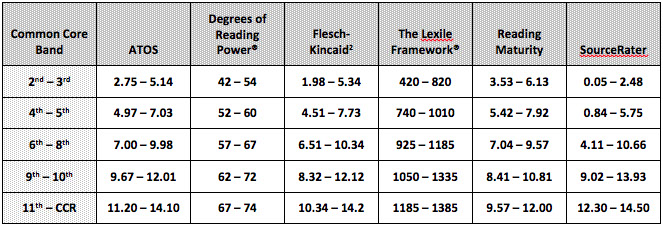Teaching Secondary Reading
A Resource for Improving Academic Literacy with Adolescents ©2015
Cognitive Rigor
 The Common Core values rigorous instruction, which can be defined as "the capacity to understand content that is complex, ambiguous, provocative, and personally or emotionally challenging" (Strong, Silver & Perrini, 2001). Instructional planners are asked to ensure cognitive rigor by having students read complex texts and engage in demanding intellectual tasks, appropriate to their developmental levels.
The Common Core values rigorous instruction, which can be defined as "the capacity to understand content that is complex, ambiguous, provocative, and personally or emotionally challenging" (Strong, Silver & Perrini, 2001). Instructional planners are asked to ensure cognitive rigor by having students read complex texts and engage in demanding intellectual tasks, appropriate to their developmental levels.
Hess's Cognitive Rigor Matrix (CRM)
This section introduces some tools to help you design cognitive rigor into your instruction. The slideshow below shows how Hess integrated Bloom's Revised Taxonomy (Remember, Understand, Apply, Analyze, Evaluate, Create) with Webb's Depth of Knowledge (DOK) Levels (Recall & Reproduction, Basic Application of Skills/Concepts, Strategic Thinking, Extended Thinking) to create her own Cognitive Rigor Matrix (CRM).
Download the matrix appropriate to your content area:
Hess's CRM can be used to define challenging tasks that are aligned to the Common Core and appropriate to your students' developmental levels.
Using a backwards design approach, after identifying your desired results, you can use Hess's CRM to determine acceptable evidence of learning. Design a demanding task, that is dependent on the use of complex text and provides practice with academic vocabulary.
Planning a Rigorous Common Core-Aligned Academic Literacy Lesson
Achieve the Core, the Student Achievement Partners website that aims to ensure "that teachers across the country are able to put the standards to work," identifies three "Core Actions" that instructional planners should focus on in order to achieve instructional rigor:
- Core Action 1: Focus each lesson on a high-quality text (or multiple texts);
- Core Action 2: Employ questions and tasks, both oral and written, that are text specific and reflect the standards; and
- Core Action 3: Provide all students with opportunities to engage in the work of the lesson.
According to the CCSS Instructional Practice Guide, "the Core Actions should be evident in planning and observable in instruction. For each lesson, artifacts or observables might include: lesson plan, text(s) and materials, tasks, teacher instruction, student discussion and behavior, and student work" (pg. 1). For a comprehensive and detailed approach to designing Common Core-aligned academic literacy lessons, Achieve the Core provides a digital planning tool. Some of those tools are highlighted below.
Core Action 1: Identifying Complex Text
One of the central challenges of teaching academic literacy in the Common Core is finding appropriate texts. The focus is on complex texts, which are not necessarily lengthy or difficult in the traditional way. The complexity of a text refers to its structure, language features, purpose, and knowledge demands. For example, more complex texts rely on implicit or subtle connections between ideas, specialized text features, abstract, ironic, and/or figurative language. The text may be dense and rely on discipline-specific or theoretical knowledge. Concepts may be abstract and include references to other texts or outside ideas. The intent of the Common Core is to build students' capacity to engage with complex texts independently. The Common Core provides sample texts in Appendix B: Text Exemplars and Sample Performance Tasks.
What if you want to use a text that does not appear there? Below is a table to shows Common Core alignment with many popular quantitative measures of text difficulty.

It is critical to also submit the text to a qualitative evaluation. Achieve the Core suggests ways to evaluate a text both quantitatively and qualitatively.
Core Action 2: Crafting High Quality Questions
The Common Core focuses students on "text-dependent" questions. As the name suggests, a text-dependent question specifically asks a question that can only be answered by referring explicitly back to the text being read. It does not rely on any particular background information outside of the text or depend on students having other experiences or knowledge; instead it privileges the text itself and what students can extract from what is before them.
In their Guide to Creating Text Dependent Questions, Achieve the Core states that text-dependent questions typically ask students to perform one or more of the following tasks:
- Analyze paragraphs on a sentence-by-sentence basis and sentences on a word-by-word basis to determine the role played by individual paragraphs, sentences, phrases, or words
- Investigate how meaning can be altered by changing key words and why an author may have chosen one word over another
- Probe each argument in persuasive text, each idea in informational text, each key detail in literary text, and observe how these build to a whole
- Examine how shifts in the direction of an argument or explanation are achieved and the impact of those shifts
- Question why authors choose to begin and end when they do
- Note and assess patterns of writing and what they achieve
- Consider what the text leaves uncertain or unstated
Here is a Quick Guide to Creating Questions, and here is a Checklist for Evaluating Question Quality.
Core Action 3: Enhancing Student Engagement
Student engagement, or "the degree of attention, curiosity, interest, optimism, and passion that students show when they are learning or being taught," is valued because students who are more engaged are believed to experience greater success in school. "Engagement" can be defined and addressed at multiple levels, and represents a key challenge to educators.
One way to enhance student emotional, social, and intellectual engagement is through cooperative learning strategies. The slideshow below addresses why cooperative learning strategies, used effectively, result in impactful learning.
Engaging students culturally means making students feel welcome and included in the classroom. One way to do that is for students to see themselves reflected in the curriculum, or what is referred to as "culturally responsive teaching." Teaching  Tolerance's Perspective for a Diverse America is a literacy-based curriculum that "marries anti-bias social justice content with the rigor of the Common Core State Standards. Their planning tools include a Central Text Anthology of complex texts from many different cultural perspectives, a bank of tasks and strategies, and an online build-your-lesson-plan tool. See also, their excellent magazine.
Tolerance's Perspective for a Diverse America is a literacy-based curriculum that "marries anti-bias social justice content with the rigor of the Common Core State Standards. Their planning tools include a Central Text Anthology of complex texts from many different cultural perspectives, a bank of tasks and strategies, and an online build-your-lesson-plan tool. See also, their excellent magazine.
Teacher Dylan Karzen
Photo by Stephanie Estrada
The views and opinions expressed on unofficial pages of California State University, Dominguez Hills faculty, staff or students are strictly those of the page authors.
The content of these pages has not been reviewed or approved by California State University, Dominguez Hills.